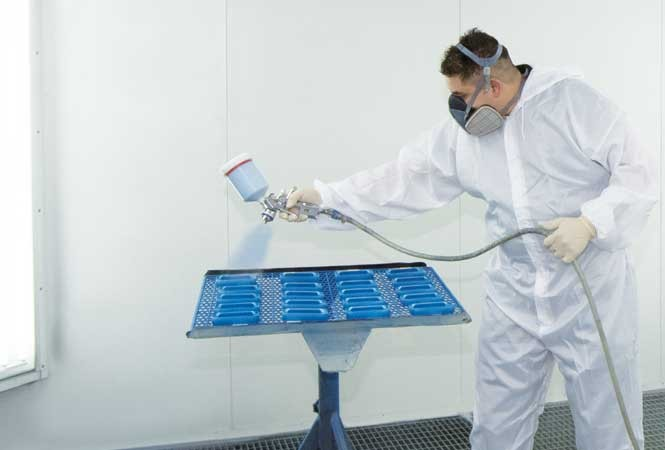Create a housing completely to your liking

Various techniques can be used to improve the functionality and appearance of a standard housing
The information in this whitepaper is sourced from our partner OKW.
Mechanical Processing
Milling, tapping, engraving, drilling, countersinking, cutting, and stamping - there are practically no limits to the variety of shapes and designs.
- Milling of recesses for interfaces, cable inlets and outlets, displays, controls, and LEDs in plastic and aluminum
- Tapping of threads >M2
- Recesses to protect decorative foils, membrane keyboards, and panels
- Reduction of internal wall thickness for partially illuminated surfaces, allowing light from behind-placed LEDs to shine through, ideal for temperature or individual status displays. Maintaining the IP protection class of the housing.
- Engraving of various inscriptions, with/without color lines
Coating
Colors and surface finishes enhance the value of devices. The colors can be produced according to RAL and in a wide range of Pantone shades. This guarantees consistently high quality and short delivery times.
- Coating in various gloss levels: as desired, from matte to glossy. Matte coatings prevent unwanted light reflections, and glossy coatings offer a refined, modern look.
- Metallic paint and color shades: finishes in a metallic look.
- Soft-Touch: paint as artificial leather to improve the feel of your product. Soft-Touch paint gives your products a velvety feel, ensuring pleasant and reliable operation of hand instruments, for example.
- Antibacterial paint: a special protective paint that prevents bacteria from settling and multiplying.
- ESD conductive paint: special paint in black to prevent electrostatic discharges.
Printing
Printing gives your product a personal touch. It is also possible to indicate the function and use through prints. Depending on the print format and type of housing or adjustment knob, screen printing, pad printing, and digital printing can be used.
- Plastic, aluminum, and steel parts: housings, control panels, display windows, front panels, covers, adjustment knobs, lids, dials
- Foils: design foils, stickers, nameplates, labels, sales packaging
- Glass: printing through digital printing
- Precise single-color and multi-color prints, color gradients are also possible
- Various versions in design, with sequential numbering and barcodes
It is possible to print on plastic surfaces (ABS, PC, ASA, ASA+PC) with a height difference of up to 1.4 mm. For lettering and color design, decorative foils can be quickly and easily made for small series.
Printing in fluorescent inks (fluorescent colors/neon colors) in screen printing/pad printing, for example yellow, orange, red, pink, and green. These fluorescent inks convert invisible UV light into visible light.
Printing with photoluminescent inks (phosphorescent inks in screen printing). These are special paints mixed with phosphorus particles. They store light energy and release it at night or in dark environments according to the luminescence principle (=cold glow).
Laser Engraving
Laser engraving is ideal for individual labeling, identification, or marking. In particular, very small machine-readable markings, such as QR codes, barcodes, DataMatrix codes, sequential numbering of individual parts, and individual texts, can be quickly and easily performed with laser engraving. Laser engraving is possible on various material types such as ABS, ASA+PC, ASA+PC-FR, PC, PA, PA GF, Aluminum. This high-contrast marking can be performed on plastic parts in various shades of white, gray, and black.
Decorative Foils
The digital printing process of decorative foils allows various versions without much effort, for example in design, with sequential numbering, codes, and technical specifications. Color gradients are also possible.
Special Material with Individual Colors
Show your colors so that your housings and controls are as unique as you want them to be. Housings and adjustment knobs can be made in special colors. To match the desired color, we can color the natural plastic material and extrude it to a high standard of reproduction. Individual color adjustments are possible according to a sample, series of dyes, RAL, or Pantone. Manufacturing housings in flame-retardant plastic material is also possible.
EMC Shielding
To shield plastic parts, which do not naturally offer protection against electromagnetic radiation, the inside of a housing can be coated with aluminum. The aluminum coating is applied in a high vacuum. The 99.98% pure aluminum is evaporated and deposited on the plastic surface within a short time. The coating thickness is approximately 2.5 µm. The aluminum coating is also characterized by good adhesion. The non-conductive material used for plastic housings, such as ABS, PC, and PA, has advantages in terms of voltage and contact protection compared to metal materials. It acts as an insulator.
Assembly of Accessories
- Assembly of housing accessories, such as cable glands, belt/pocket clips, tilt feet, wall mounts, hinges, handles, and much more.
- Application of keyboard foils, decorative foils, nameplates, display windows, mounting pillars
- Assembly of assemblies, installation of components
- Assembly and packaging according to customer specifications, such as seals, optical fibers
